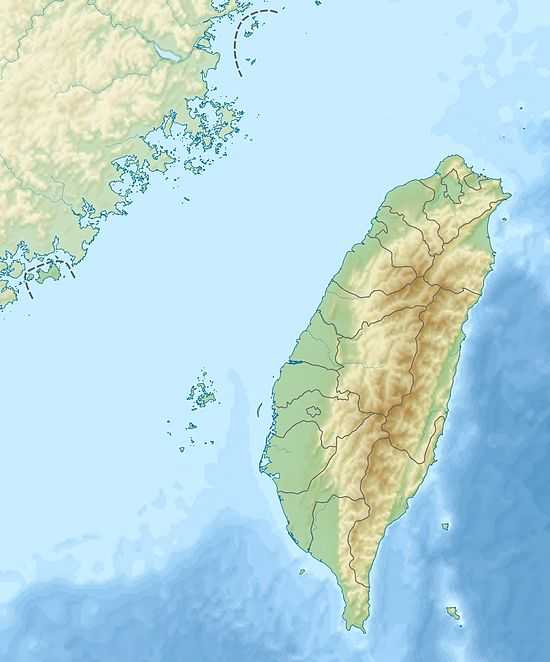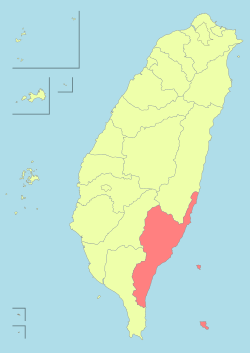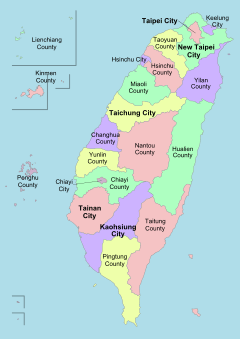Orchid Island
Coordinates: 22°03′N 121°32′E / 22.050°N 121.533°E


Orchid Island (Yami: Ponso no Tao; Chinese: 蘭嶼; pinyin: Lán Yǔ; Pe̍h-ōe-jī: Lân-sū) is a 45 km² high island off the southeastern coast of Taiwan Island and separated from the Batanes of the Philippines by the Bashi Channel of the Luzon Strait. It is governed as Lanyu Township of Taitung County, Taiwan.
The island is home to the Tao, an ethnic minority group who migrated to the island from the Batan Archipelago 800 years ago. The island is known to them as Ponso no Tao "Island of the people" or Irala. Out of a total current population of 4000, approximately 2400 belong to the aboriginal Tao community and the remaining 1600 are mainly Han Chinese. In neighboring Philippines the island is referred to as Botel Tobago.
The Lanyu nuclear waste storage facility was built in 1982. The plant receives nuclear waste from Taiwan's three nuclear power plants operated by state utility Taiwan Power Company (Taipower). About 100,000 barrels of nuclear waste from the nation’s three operational nuclear power plants have been stored at the Lanyu complex.[1] In 2002 and 2012, there were major protests from local residents, calling on Taipower to remove the nuclear waste from the island.[2]
History
.jpg)
Early history
The island was first mapped on Japanese charts as Tabako-shima in the early 17th century and Tabaco Xima on a French map of 1654. The Chinese, who had no contact with the inhabitants of the island, called it Ang-thau-su (Chinese: 紅頭嶼; pinyin: Hóngtóuyǔ; Pe̍h-ōe-jī: Âng-thâu-sū; l="Red-headed island"), from which it was called Japanese: Kōtō-sho during Japanese rule of Taiwan. The Japanese government declared the island an ethnological research area off-limits to the public.
Republic of China
This restriction remained in effect when the Republic of China took over Taiwan in 1945, but was lifted in 1967. It was because of the restriction that the Tao have the best preserved traditions among the Taiwanese aborigines. Since then, schools were built on the island and education in Taiwanese Mandarin became compulsory. Tourism to the island has also increased. The island is known by the Amis people as Buturu and by the Puyuma as Botol.
On January 19, 1946, the island was designated as Hongtouyu Township (traditional Chinese: 紅頭嶼鄉 "Red-headed Island") of Taitung County. November 24 of that year, it was renamed Lanyu or Orchid Island, after the local Phalaenopsis orchids.
Geography

There are eight mountains over 400 m high. The tallest mountain is Mt. Hongtoushan (紅頭山) at 552 m. The rock on the island is volcanic tholeiite andesite, and volcanic explosive fragments. The volcano erupted in the Miocene to Miocene period. It is part of the Luzon Volcanic Arc. Magma was formed from underthrusting oceanic crust under compression about 20 km deep. The andesite rock contains some visible crystals of pyroxene or amphibole. The geochemistry of the rock shows it is enriched in sodium, magnesium and nickel, but depleted in iron, aluminium, potassium titanium and strontium.[4]
As the island is within the tropics, the island experiences a warm and rainy tropical climate throughout the year with humidity often reaching more than 90%. Rainfall, abundant throughout the year, cools the temperature significantly. The climate is classified as a monsoon-influenced Koppen's tropical rainforest climate (Af), with annual temperatures averaging around 23 °C on the mountain and 26 °C on the coasts, one of the highest in Taiwan.
Lesser Orchid Island (Wade-Giles: Hsiao Lan Yü; Pinyin: Xiao Lanyu; Little Botel-Tobago), an uninhabited volcanic islet near the main Orchid Island, is the southernmost point of Taitung County. It has been the target of military airplanes' target practice. It is home to a critically endangered endemic orchid, Phalaenopsis equestris f. aurea.
| Climate data for Lanyu Weather Station - 324m above sea level (1981–2010) | |||||||||||||
|---|---|---|---|---|---|---|---|---|---|---|---|---|---|
| Month | Jan | Feb | Mar | Apr | May | Jun | Jul | Aug | Sep | Oct | Nov | Dec | Year |
| Average high °C (°F) | 20.7 (69.3) |
21.4 (70.5) |
23.0 (73.4) |
24.9 (76.8) |
26.7 (80.1) |
27.8 (82) |
28.6 (83.5) |
28.5 (83.3) |
27.6 (81.7) |
25.9 (78.6) |
23.8 (74.8) |
21.4 (70.5) |
25.02 (77.04) |
| Daily mean °C (°F) | 18.5 (65.3) |
19.0 (66.2) |
20.5 (68.9) |
22.4 (72.3) |
24.3 (75.7) |
25.7 (78.3) |
26.3 (79.3) |
26.1 (79) |
25.2 (77.4) |
23.8 (74.8) |
21.7 (71.1) |
19.4 (66.9) |
22.74 (72.93) |
| Average low °C (°F) | 17.0 (62.6) |
17.4 (63.3) |
18.8 (65.8) |
20.8 (69.4) |
22.2 (72) |
24.1 (75.4) |
24.6 (76.3) |
24.3 (75.7) |
23.5 (74.3) |
22.3 (72.1) |
20.3 (68.5) |
17.9 (64.2) |
21.1 (69.97) |
| Average rainfall mm (inches) | 248.1 (9.768) |
203.9 (8.028) |
154.0 (6.063) |
149.0 (5.866) |
249.3 (9.815) |
287.4 (11.315) |
231.2 (9.102) |
287.9 (11.335) |
384.2 (15.126) |
305.6 (12.031) |
267.0 (10.512) |
212.2 (8.354) |
2,979.8 (117.315) |
| Avg. rainy days (≥ 0.1 mm) | 22.2 | 19.0 | 16.7 | 15.1 | 15.7 | 15.3 | 14.2 | 16.6 | 19.5 | 19.6 | 20.5 | 21.0 | 215.4 |
| Average relative humidity (%) | 86.3 | 88.3 | 88.6 | 90.2 | 90.3 | 92.1 | 91.0 | 90.8 | 90.3 | 87.3 | 86.6 | 84.9 | 88.89 |
| Mean monthly sunshine hours | 80.8 | 78.8 | 106.0 | 113.0 | 136.5 | 140.8 | 196.2 | 171.6 | 143.7 | 134.1 | 94.7 | 77.6 | 1,473.8 |
| Source: [5] | |||||||||||||
| Climate data for Lanyu Township - Hongtou Village | |||||||||||||
|---|---|---|---|---|---|---|---|---|---|---|---|---|---|
| Month | Jan | Feb | Mar | Apr | May | Jun | Jul | Aug | Sep | Oct | Nov | Dec | Year |
| Average high °C (°F) | 24.0 (75.2) |
25.0 (77) |
26.6 (79.9) |
28.7 (83.7) |
30.6 (87.1) |
31.6 (88.9) |
32.3 (90.1) |
32.1 (89.8) |
31.0 (87.8) |
29.5 (85.1) |
27.2 (81) |
24.8 (76.6) |
28.62 (83.52) |
| Daily mean °C (°F) | 21.4 (70.5) |
22.2 (72) |
23.8 (74.8) |
25.8 (78.4) |
27.8 (82) |
28.9 (84) |
29.6 (85.3) |
29.3 (84.7) |
28.4 (83.1) |
27.0 (80.6) |
24.8 (76.6) |
22.4 (72.3) |
25.95 (78.69) |
| Average low °C (°F) | 19.4 (66.9) |
19.8 (67.6) |
21.4 (70.5) |
23.4 (74.1) |
24.9 (76.8) |
26.6 (79.9) |
27.4 (81.3) |
27.0 (80.6) |
26.0 (78.8) |
25.0 (77) |
22.8 (73) |
20.4 (68.7) |
23.67 (74.6) |
| Average rainfall mm (inches) | 240.1 (9.453) |
188.9 (7.437) |
144.0 (5.669) |
159.0 (6.26) |
232.3 (9.146) |
270.4 (10.646) |
241.2 (9.496) |
257.9 (10.154) |
390.2 (15.362) |
295.6 (11.638) |
227.0 (8.937) |
268.2 (10.559) |
2,914.8 (114.757) |
| Mean monthly sunshine hours | 82.8 | 79.8 | 110.0 | 119.0 | 145.5 | 142.8 | 202.2 | 183.6 | 143.7 | 136.1 | 90.7 | 72.6 | 1,508.8 |
| Source: [6] | |||||||||||||
Administrative divisions

There are seven villages (社) in Lanyu Township, which are: (The asterisks indicate the four current administrative villages (村)
| Yami name | Chinese | Note |
|---|---|---|
| Yayu | Yeyou (椰油) | * |
| Iraralay | Langdao (朗島) | * |
| Iranumilk | Dongqing (東清) | * |
| Ivarinu | Yeyin (野銀) | not an administrative village |
| Imourud | Hongtou (紅頭) | * Redhead Village, township seat |
| Iratai | Yuren (漁人) | Incorporated into Imourud Village in 1946 |
| Iwatas | Yiwadasi (伊瓦達斯) | Incorporated into Yayu in 1940 |
Flora and fauna
Orchid Island hosts many tropical plants species, sharing many species with tropical Asia but also many endemics: there are 35 plant species found nowhere else.[7] For example, Pinanga tashiroi is a species of palm tree found nowhere else than Orchid Island.[8]
Green sea turtles are nesting on the island.[9] The island is surrounded by coral reefs.[10] Four species of sea snakes inhabit the waters round the island.[11]
Economy
The islanders are mostly farmers and fishermen relying on a large annual catch of flying fish and on wet taro, yams, and millet. They are the Tao people.
On 19 September 2014, the first 7-Eleven store in the island was opened. During the opening ceremony, the township chief said that the store could provide conveniences to the local residents such as fee and tax collection.[12]
Energy
Nuclear waste
The Lanyu nuclear waste storage facility was built at the southern tip of Orchid Island in 1982. The plant receives nuclear waste from Taiwan's three nuclear power plants operated by state utility Taiwan Power Company (Taipower). Islanders did not have a say in the decision to locate the facility on the island.[1]
In 2002, almost 2,000 protesters, including many Aboriginal residents of Taiwan's Orchid Island and elementary and high school students, staged a sit-in in front of the storage plant, calling on Taipower to remove nuclear waste from the island. They were also protesting against the government's failure to keep its pledge to withdraw 100,000 barrels of low-level nuclear waste from their isle by the end of 2002.[1] In a bid to allay safety concerns, Taipower has pledged to repackage the waste since many of the iron barrels used for storage have become rusty from the island's salty and humid air. Taipower has for years been exploring ways to ship the nuclear waste overseas for final storage, but plans to store the waste in an abandoned North Korean coal mine have met with strong protests from neighboring South Korea and Japan due to safety and environmental concerns, while storage in Russia or China is complicated by political factors. Taipower is "trying to convince the islanders to extend the storage arrangement for another nine years in exchange for payment of NT$200 million (about $5.7 million)".[1]
Following years of protests by Lanyu residents, more concerns arose about the facility, after Japan’s Fukushima nuclear disaster in 2011. A report released in November 2011 said a radioactive leak had been detected outside the facility and this has added to residents’ concerns. In February 2012, hundreds of Tao Aborigines living on Lanyu held a protest outside the Lanyu nuclear waste storage facility, calling on Taiwan Power Co. to remove nuclear waste from the island as soon as possible.[2] Chang Hai-yu, a preacher at a local church, said "it was a tragedy that Tao children are being born into a radiation-filled environment". Lanyu Township Mayor Chiang To-li "urged Taipower to remove nuclear waste from the island as soon as possible".[2]
In March 2012, about 2,000 people staged an anti-nuclear protest in Taiwan's capital following the massive earthquake and tsunami that hit Japan one year ago. Scores of aboriginal protesters "demanded the removal of 100,000 barrels of nuclear waste stored on Orchid Island, off south-eastern Taiwan. Authorities have failed to find a substitute storage site amid increased awareness of nuclear danger over the past decade".[13][14]
Power generation
The island houses its only power generation facility, the fuel-fired Lanyu Power Plant. Commissioned in 1982, the plant has a total installed capacity of 6.5 MW and is owned and operated by Taipower. Stipulated under the Article 14 of the Offshore Islands Development Act, residents in the island enjoy free electricity for households, except businesses. The situation on the island was resulted from the preferential policy given to the island residents due to the construction of the Lanyu storage site on the island in 1982.[15]
However, due to this free electricity usage, electricity consumption in the island is generally much higher than in other parts of Taiwan. In 2011, the average annual electricity consumption per household in Lanyu was 6,522 kWh, almost twice as much as the average 3,654 kWh across Taiwan. In 2002, Taipower provided an equivalent of NT$6.35 million worth of electricity to the island, and in 2011 the amount rose up to NT$24.39 million. Due to this suspected abuse activities which has been going on for a while, member of Control Yuan called on an investigation into this electricity subsidy to Lanyu Island in 2012.[16]
Tourist attractions
Transport

The island is accessible by sea or air. Daily Air is the only airline to offer flights from Taiwan Island through Taitung Airport in Taitung City to Orchid Island through its Lanyu Airport. The flight duration is half an hour and the daily frequency is dependent on weather conditions. Ferry trips to the island are available from Taitung City's Fugang Fishery Harbor year round, while in the summer, there is a ferry from Houbihu port in Kenting.
Gallery
-
Taiwan
-
Sunset at the beach
-
Men's traditional dance
-
Women's traditional dance
-
Langdao beach
-
Drying fish
-
Traditional canoe
See also
- List of volcanoes in Taiwan
- Green Island - the other offshore township of Taitung County
- List of islands of the Republic of China
- Tao people
References
- ↑ 1.0 1.1 1.2 1.3 "Orchid Island launches new protests against nuclear waste". Asian Economic News. May 6, 2002.
- ↑ 2.0 2.1 2.2 Loa Iok-sin (21 February 2012). "Tao protest against nuclear facility". Taipei Times.
- ↑ Karl Theodor Stöpel (1905). Eine Reise in das Innere der Insel Formosa.
- ↑ Zhang Jinhai and He Lishi (2002). "Geology of Taiwan Province". Geology of China. Geological Publishing House. ISBN 7-116-02268-6.
- ↑ "Statistics > Monthly Mean". Central Weather Bureau.
- ↑ "Statistics > Monthly Mean". Central Weather Bureau.
- ↑ Hsieh, Chang-Fu (2002). "Composition, endemism and phytogeographical affinities of the Taiwan flora". Taiwania 47: 298–310.
- ↑ Liao, Jih-Ching (2000). "Palmae (Arecaceae)". In Huang, Tseng-chieng. Flora of Taiwan 5 (2nd ed.). Taipei, Taiwan: Editorial Committee of the Flora of Taiwan, Second Edition. pp. 655–662. ISBN 957-9019-52-5. Retrieved 2 October 2012.
- ↑ Cheng, I-Jiunn; Cheng-Ting Huang, Po-Yen Hung, Bo-Zong Ke, Chao-Wei Kuo, and Chia-Ling Fong (2009). "Ten years of monitoring the nesting ecology of the green turtle, Chelonia mydas, on Lanyu (Orchid I.), Taiwan". Zoological Studies 48 (1): 83–94.
- ↑ Dai, C.-F. (1991). "Reef environment and coral fauna of southern Taiwan". Atoll Research Bulletin 354: 1–24. doi:10.5479/si.00775630.354.1.
- ↑ Tu, M. C.; M. C. Tu, S. C. Fong and K. Y. Lue (1990). "Reproductive biology of the sea snake, Laticauda semifasciata, in Taiwan". Journal of Herpetology 24 (2): 119–126. JSTOR 1564218.
- ↑ http://www.taipeitimes.com/News/taiwan/archives/2014/09/20/2003600152
- ↑ "About 2,000 Taiwanese stage anti-nuclear protest". Straits Times. 11 March 2011.
- ↑ http://www.abc.net.au/foreign/content/2013/s3733236.htm
- ↑ http://www.wantchinatimes.com/news-subclass-cnt.aspx?id=20120716000064&cid=1103
- ↑ http://www.chinapost.com.tw/taiwan/local/offshore-islands/2012/07/17/347845/Control-Yuan.htm
External links
| Wikimedia Commons has media related to Orchid Island. |
- Taiwan Aborigine Monograph Series 2
- Taipei Multicultural Arts Group
- The Yami on Botel Tobago
- Cultural Survival on Orchid Island
- No place for nuclear waste
- Taipower, North Korea strike accord on nuke waste storage
- Nuclear dump dispute on Orchid Island
- Orchid Island: Taiwan's nuclear dumpsite
- Local hostel info(in Chinese)
| |||||||||||||||||||||
| |||||||||||||||||||||||||||||||||||||||||||||||||||||||||||||||||||||||||||||||||||||
| |||||||||||||||||||||||||||||||||||||









